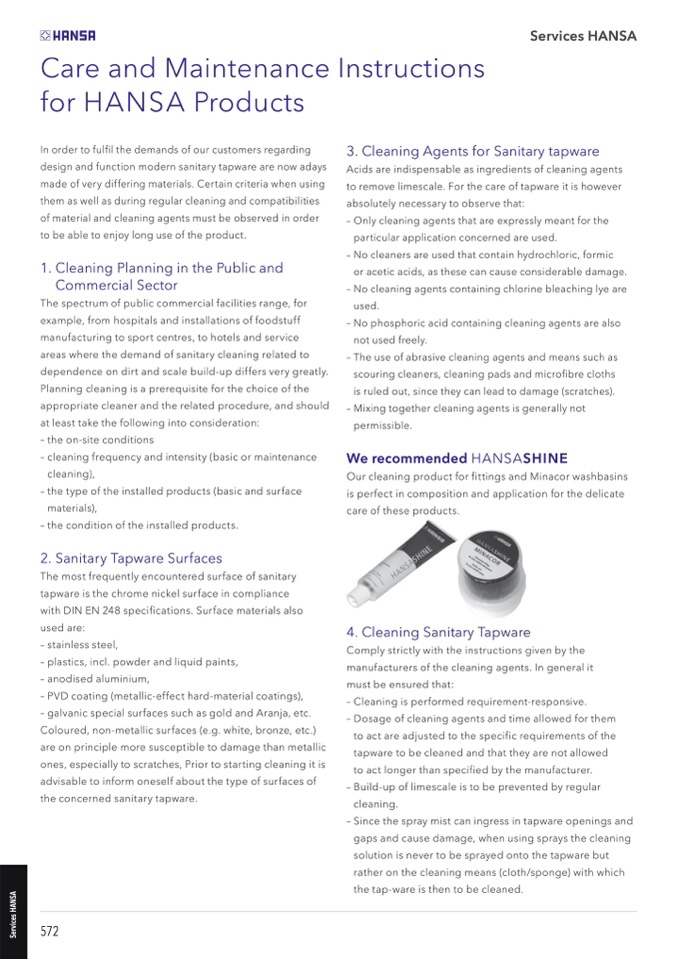
Care and Maintenance Instructions
for HANSA Products
In order to fulfil the demands of our customers regarding
design and function modern sanitary tapware are now adays
made of very differing materials. Certain criteria when using
them as well as during regular cleaning and compatibilities
of material and cleaning agents must be observed in order
to be able to enjoy long use of the product.
1. Cleaning Planning in the Public and
Commercial Sector
The spectrum of public commercial facilities range, for
example, from hospitals and installations of foodstuff
manufacturing to sport centres, to hotels and service
areas where the demand of sanitary cleaning related to
dependence on dirt and scale build-up differs very greatly.
Planning cleaning is a prerequisite for the choice of the
appropriate cleaner and the related procedure, and should
at least take the following into consideration:
– the on-site conditions
– cleaning frequency and intensity (basic or maintenance
cleaning),
– the type of the installed products (basic and surface
materials),
– the condition of the installed products.
2. Sanitary Tapware Surfaces
The most frequently encountered surface of sanitary
tapware is the chrome nickel surface in compliance
with DIN EN 248 specifications. Surface materials also
used are:
– stainless steel,
– plastics, incl. powder and liquid paints,
– anodised aluminium,
– PVD coating (metallic-effect hard-material coatings),
– galvanic special surfaces such as gold and Aranja, etc.
Coloured, non-metallic surfaces (e.g. white, bronze, etc.)
are on principle more susceptible to damage than metallic
ones, especially to scratches, Prior to starting cleaning it is
advisable to inform oneself about the type of surfaces of
the concerned sanitary tapware.
3. Cleaning Agents for Sanitary tapware
Acids are indispensable as ingredients of cleaning agents
to remove limescale. For the care of tapware it is however
absolutely necessary to observe that:
– Only cleaning agents that are expressly meant for the
particular application concerned are used.
– No cleaners are used that contain hydrochloric, formic
or acetic acids, as these can cause considerable damage.
– No cleaning agents containing chlorine bleaching lye are
used.
– No phosphoric acid containing cleaning agents are also
not used freely.
– The use of abrasive cleaning agents and means such as
scouring cleaners, cleaning pads and microfibre cloths
is ruled out, since they can lead to damage (scratches).
– Mixing together cleaning agents is generally not
permissible.
We recommended HANSASHINE
Our cleaning product for fittings and Minacor washbasins
is perfect in composition and application for the delicate
care of these products.
4. Cleaning Sanitary Tapware
Comply strictly with the instructions given by the
manufacturers of the cleaning agents. In general it
must be ensured that:
– Cleaning is performed requirement-responsive.
– Dosage of cleaning agents and time allowed for them
to act are adjusted to the specific requirements of the
tapware to be cleaned and that they are not allowed
to act longer than specified by the manufacturer.
– Build-up of limescale is to be prevented by regular
cleaning.
– Since the spray mist can ingress in tapware openings and
gaps and cause damage, when using sprays the cleaning
solution is never to be sprayed onto the tapware but
rather on the cleaning means (cloth/sponge) with which
the tap-ware is then to be cleaned.
Services HANSA
572
S
e
r
v
i
c
e
s
H
A
N
S
A

